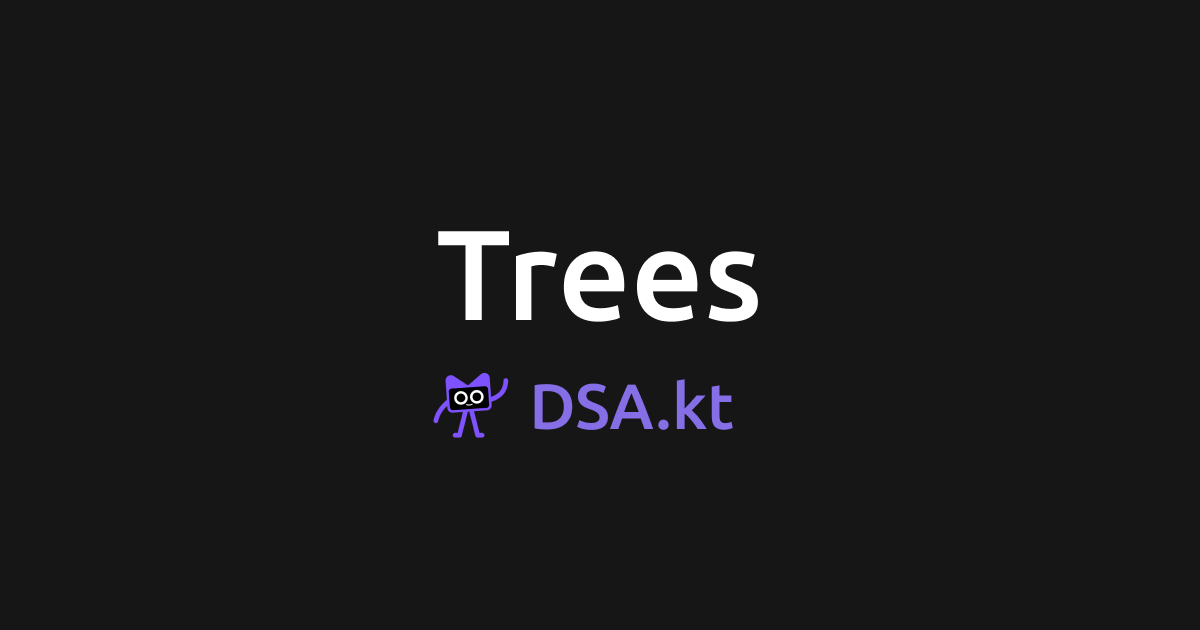Trees in Kotlin

1. Introduction
Trees are hierarchical data structures widely used in computer science for representing relationships between elements. They consist of nodes connected by edges, with one root node at the top and child nodes forming subtrees below.
In Kotlin, trees can be implemented using classes and data structures, providing flexibility to represent various tree types, such as binary trees, binary search trees (BST), and n-ary trees. Understanding trees is crucial for solving problems related to searching, sorting, and hierarchical data representation.
2. Overview of Trees
Definition and Purpose
A tree is a collection of nodes, where each node contains data and references to its child nodes. Trees are used extensively for organizing data in a way that facilitates efficient insertion, deletion, and traversal.
Key Characteristics
- Root Node: The topmost node in the tree.
- Child Nodes: Nodes directly connected to a parent node.
- Leaf Nodes: Nodes without any children.
- Height: The number of edges on the longest path from the root to a leaf.
- Depth: The number of edges from the root to a given node.
Common Scenarios
- Hierarchical data (e.g., file systems, organizational charts).
- Search operations (e.g., binary search trees).
- Priority queues (e.g., heaps).
3. Tree Implementations in Kotlin
Representing a Node
In Kotlin, a tree node can be represented using a class or data class. Each node stores a value and references to its child nodes.
Example: Node Class
class TreeNode<T>(
val value: T,
val children: MutableList<TreeNode<T>> = mutableListOf()
)
Types of Trees
1. Binary Tree
A binary tree is a tree where each node has at most two children, referred to as the left and right child.
Example:
class BinaryTreeNode<T>(
val value: T,
var left: BinaryTreeNode<T>? = null,
var right: BinaryTreeNode<T>? = null
)
2. Binary Search Tree (BST)
A BST is a binary tree with the additional property that the value of each node is greater than all the values in its left subtree and less than those in its right subtree.
Example:
class BinarySearchTree {
var root: BinaryTreeNode<Int>? = null
fun insert(value: Int) {
root = insertRec(root, value)
}
private fun insertRec(node: BinaryTreeNode<Int>?, value: Int): BinaryTreeNode<Int> {
if (node == null) return BinaryTreeNode(value)
if (value < node.value) node.left = insertRec(node.left, value)
else if (value > node.value) node.right = insertRec(node.right, value)
return node
}
}
3. N-ary Tree
An n-ary tree is a tree where each node can have an arbitrary number of children.
Example:
class NaryTreeNode<T>(
val value: T,
val children: MutableList<NaryTreeNode<T>> = mutableListOf()
)
4. Tree Traversals
Tree traversal refers to visiting all the nodes in a tree in a specific order. The most common traversal methods are:
1. Depth-First Traversal (DFS)
Inorder (Left, Root, Right):
fun <T> inorderTraversal(node: BinaryTreeNode<T>?) {
if (node != null) {
inorderTraversal(node.left)
println(node.value)
inorderTraversal(node.right)
}
}
Preorder (Root, Left, Right):
fun <T> preorderTraversal(node: BinaryTreeNode<T>?) {
if (node != null) {
println(node.value)
preorderTraversal(node.left)
preorderTraversal(node.right)
}
}
Postorder (Left, Right, Root):
fun <T> postorderTraversal(node: BinaryTreeNode<T>?) {
if (node != null) {
postorderTraversal(node.left)
postorderTraversal(node.right)
println(node.value)
}
}
2. Breadth-First Traversal (BFS)
BFS visits all nodes at the current depth before moving to the next level. It is typically implemented using a queue.
Example:
fun <T> bfsTraversal(root: BinaryTreeNode<T>?) {
if (root == null) return
val queue: Queue<BinaryTreeNode<T>> = LinkedList()
queue.add(root)
while (queue.isNotEmpty()) {
val node = queue.poll()
println(node.value)
node.left?.let { queue.add(it) }
node.right?.let { queue.add(it) }
}
}
5. TreeMap and TreeSet in Kotlin
TreeMap
A TreeMap is a map that stores keys in sorted order. It is part of the Java standard library and can be used in Kotlin for scenarios where a sorted map is required.
Example:
val treeMap = java.util.TreeMap<String, Int>()
treeMap["Apple"] = 3
treeMap["Banana"] = 5
treeMap["Cherry"] = 2
for ((key, value) in treeMap) {
println("$key -> $value")
}
TreeSet
A TreeSet is a set that keeps its elements sorted. Like TreeMap, it is part of the Java standard library but can be seamlessly used in Kotlin.
Example:
val treeSet = java.util.TreeSet<Int>()
treeSet.add(10)
treeSet.add(5)
treeSet.add(20)
for (element in treeSet) {
println(element)
}
6. Examples and Use Cases
Example 1: Constructing a Binary Tree
val root = BinaryTreeNode(1)
root.left = BinaryTreeNode(2)
root.right = BinaryTreeNode(3)
root.left?.left = BinaryTreeNode(4)
root.left?.right = BinaryTreeNode(5)
Example 2: Checking if a Tree is a BST
fun isBST(node: BinaryTreeNode<Int>?, min: Int? = null, max: Int? = null): Boolean {
if (node == null) return true
if ((min != null && node.value <= min) || (max != null && node.value >= max)) return false
return isBST(node.left, min, node.value) && isBST(node.right, node.value, max)
}
7. Performance and Best Practices
Performance Considerations
- Balanced Trees: Ensure the tree remains balanced for optimal performance.
- Recursive Depth: Avoid excessive recursion depth to prevent stack overflow for deep trees.
Best Practices
- Choose the Right Type: Use BSTs for sorted data and n-ary trees for hierarchical structures.
- Validate Input: Check inputs before inserting them into the tree.
- Optimize Traversals: Use iterative traversals for large trees to save memory.
8. Conclusion
Trees are versatile and powerful data structures that form the backbone of many algorithms and applications. With Kotlin’s flexible class system, you can easily implement and manipulate different types of trees. Additionally, TreeMap and TreeSet provide sorted data handling capabilities directly through the Java standard library. Mastering tree structures and their traversals will elevate your problem-solving skills and make you a more effective developer.
Start exploring trees in Kotlin to unlock their full potential!